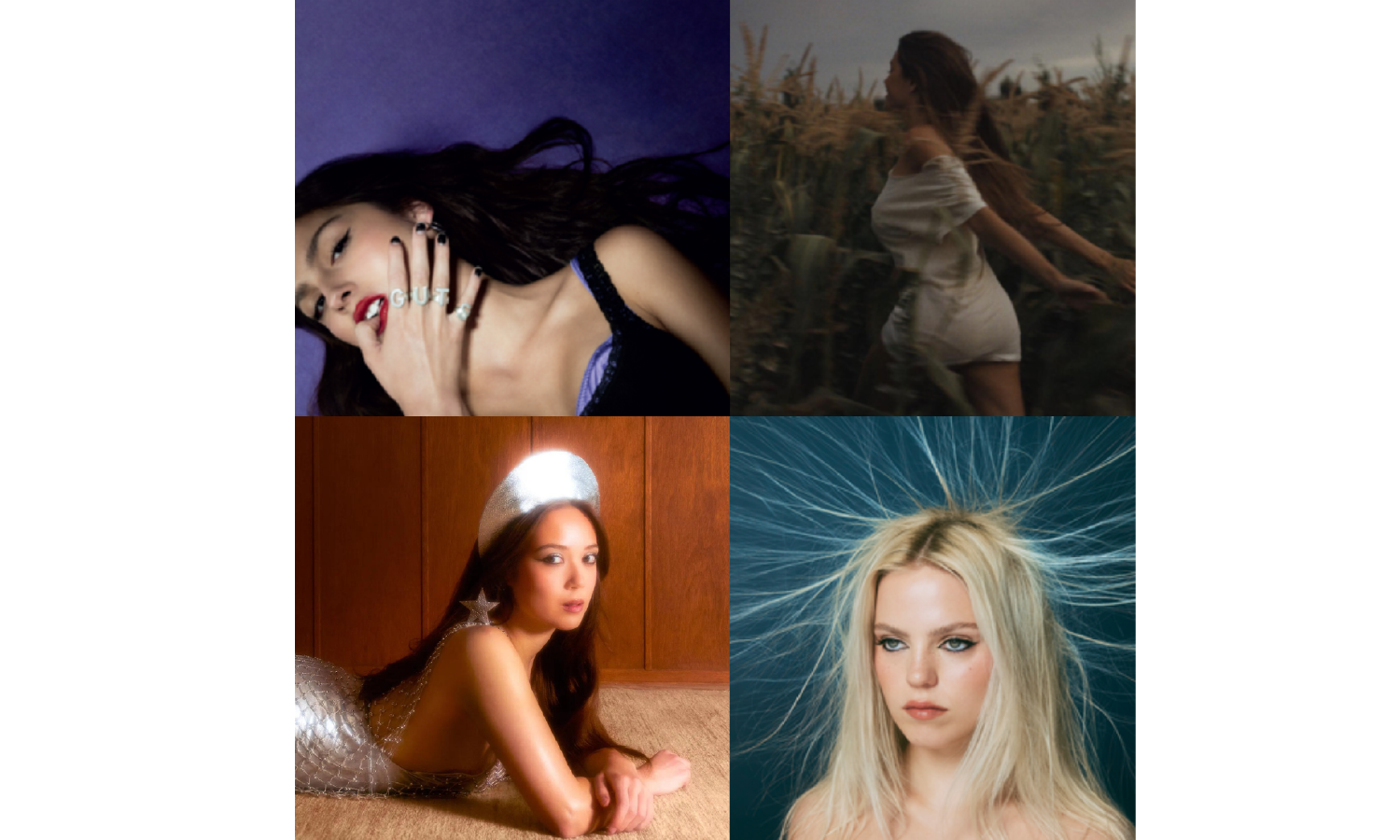The music releases of 2022 and 2023 are prompting questions about the future of the music industry at large. Photos courtesy of Spotify.
ABIGAIL OAKLEY | CULTURE CO-EDITOR | aloakley@buter.edu
From Madonna to Britney Spears to Taylor Swift, as long as there has been pop music, there have been female pop icons that have risen to the top. As Gen Z gets older, a new generation of these pop icons is beginning to surface. The recent releases and successes of Olivia Rodrigo’s “GUTS”, Reneé Rapp’s “Snow Angel”, Sabrina Carpenter’s “Emails I Can’t Send” and Madison Beer’s “Silence Between Songs” signal that this new generation is ready to take center stage in pop culture.
Madison Beer popped up as a model and influencer before using that fame to propel her music career. Olivia Rodrigo and Sabrina Carpenter were Disney Channel stars before launching their music careers. And Reneé Rapp came into the mainstream with her Broadway debut as Regina George in “Mean Girls”. These stars have gotten their start in a multitude of ways, but they all have one thing in common — TikTok.
Each star used their previously established following on social media from those experiences to advertise their music career. This includes older platforms such as Instagram and X — formerly known as Twitter — but the real difference is made on TikTok. Stars like these use TikTok as a way to stay in the public consciousness and make their projects known. Artists advertise their music on TikTok, where they already have a fanbase that is ready to support them. These fans boost the music’s popularity by spreading it around the platform. Numerous Olivia Rodrigo songs have quickly spurred trends on the platform, mainly singing along to her music. All of this makes it easier for these artists with pre-existing fanbases to rise quickly.
This is not a new story. Celebrities have often benefited from pre-existing fanbases to market themselves. However, something about this generation is different. The more recent social media platforms provide new methods of connecting with fans virtually. Artists have more opportunities for content and often seem more “relatable.”
Senior music education major Kelly Kirk is a fan of Reneé Rapp because of her relatability.
“[Reneé Rapp] comes across as a more casual artist,” Kirk said. “She’s seen as more of a normal person, as opposed to other artists who aren’t on TikTok and have such a high platform that you can’t even imagine getting as close to that artist as to Reneé Rapp.”
Relatability is a trend even among slightly smaller artists, such as Lizzy McAlpine and Laufey. Both of these artists speak to the young female audience with songs about heartbreak, friendship and growing up. Smaller indie-pop artists have been exploding in recent years. Some attribute this to their easy-going public images and the general public’s greater ability to find new music through TikTok and Spotify.
Junior English major Logan Goettemoeller is a long-time fan of Lizzy McAlpine and is excited to see her recent rise in popularity.
“It’s been really cool to see her blow up,” Goettemoeller said. “There’s been a big emergence of indie-pop [lately]. There’s a lot of talent in that area. And there’s a feeling of [familiarity] and relatability that makes artists like [McAlpine] a lot more marketable.”
However, the newfound accessibility of artists from social media comes at a cost. Artists can more easily advertise themselves as “relatable” and prompt parasocial relationships. In fact, Gen Z is more likely to develop deep parasocial relationships with celebrities than generations prior. Fans expect to know the goings-on in their favorite artists’ lives. They are also more invested in any potential drama.
Rodrigo and Carpenter have experienced this first-hand. After the release of Rodrigo’s “Driver’s License” and Carpenter’s “Skin” in 2021, fans relentlessly speculated that the songs alluded to a feud between the two singers over mutual ex-boyfriend Joshua Bassett. Whether true or not, some people thought these speculations became an invasion of privacy. Prior to platforms like TikTok, this conversation would have been confined to more niche communities. However, in this new landscape, fans have nearly unlimited space to voice their opinions through videos and comments. Additionally, these videos and comments can reach people on the platform who may not have sought the information out on their own.
Not only are fans more invested in drama, but artists are more reliant on their images than ever before. Madison Beer first became famous as a model and influencer often cited for her conventionally attractive looks.
First-year music industry studies major Chase Weckenmann is a fan of Beer and thinks that her brand has been holding her back.
“When I’ve talked to people about Madison Beer in the past the first thing I hear is, ‘Oh, she’s hot,’” Weckenmann said. “I feel like that needs to change … [I think that] a lot of what her team does is put her with Victoria’s Secret [and companies like that] for modeling. They aren’t giving her more music-focused [opportunities].”
When artists like Beer are reliant on their image, they can be reluctant to make moves that change it. Die-hard fans can react with hostility when their favorite artists do things contrary to their image. Navigating these struggles can be difficult. This challenge may explain why many young artists are experiencing burnout so early in their careers. Music artists must put out content nearly every day in order to remain relevant. Many artists have expressed frustration with the constant need to put themselves in front of the camera.
As long as they remain in the public eye, it seems that these pop stars will continue rising. Unfortunately, the same tools that created that rise could also create their fall. This generation of pop icons is dealing with unprecedented issues, and only time will tell what that means for the music industry at large.



